Themed collection Machine learning and artificial neural networks: Celebrating the 2024 Nobel Prize in Physics

Artificial intelligence-navigated development of high-performance electrochemical energy storage systems through feature engineering of multiple descriptor families of materials
With increased awareness of artificial intelligence-based algorithms coupled with the non-stop creation of material databases, artificial intelligence (AI) can facilitate fast development of high-performance electrochemical energy storage systems (EESSs).

Energy Adv., 2023,2, 615-645
https://doi.org/10.1039/D3YA00104K
Neural network potentials for chemistry: concepts, applications and prospects
Artificial Neural Networks (NN) are already heavily involved in methods and applications for frequent tasks in the field of computational chemistry such as representation of potential energy surfaces (PES) and spectroscopic predictions.

Digital Discovery, 2023,2, 28-58
https://doi.org/10.1039/D2DD00102K
A review of recent advances and applications of machine learning in tribology
This review summarises recent advances in the use of machine learning for predicting friction and wear in tribological systems, material discovery, lubricant design and composite formulation. Potential future applications and areas for further research are also discussed.
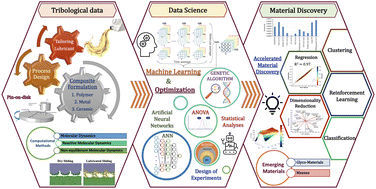
Phys. Chem. Chem. Phys., 2023,25, 4408-4443
https://doi.org/10.1039/D2CP03692D
Natural product drug discovery in the artificial intelligence era
Natural products (NPs) are primarily recognized as privileged structures to interact with protein drug targets.
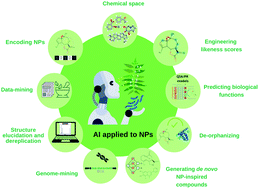
Chem. Sci., 2022,13, 1526-1546
https://doi.org/10.1039/D1SC04471K
Leveraging machine learning in porous media
Evaluating the advantages and limitations of applying machine learning for prediction and optimization in porous media, with applications in energy, environment, and subsurface studies.

J. Mater. Chem. A, 2024,12, 20717-20782
https://doi.org/10.1039/D4TA00251B
Employing nano-enabled artificial intelligence (AI)-based smart technologies for prediction, screening, and detection of cancer
AI enabled imaging technology advances the precision, early detection, and personalizes treatment through analysis and interpretation of medical images.
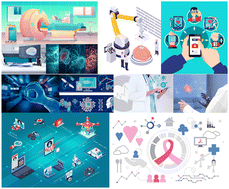
Nanoscale, 2024,16, 5458-5486
https://doi.org/10.1039/D3NR05648A
Computing of neuromorphic materials: an emerging approach for bioengineering solutions
Machine learning techniques for the development of neuromorphic materials for bioengineering solutions by developing energy-efficient hardware, enhancing neuron models, and learning algorithms.

Mater. Adv., 2023,4, 5882-5919
https://doi.org/10.1039/D3MA00449J
Machine learning-based inverse design methods considering data characteristics and design space size in materials design and manufacturing: a review
This review offers a guideline for selecting the ML-based inverse design method, considering data characteristics and design space size. It categorizes challenges and underscores the proper methods, with a focus on composites and its manufacturing.

Mater. Horiz., 2023,10, 5436-5456
https://doi.org/10.1039/D3MH00039G
A review on the application of molecular descriptors and machine learning in polymer design
Molecular descriptors and machine learning are useful tools for extracting structure–property relationships from large, complex polymer data, and accelerating the design of novel polymers with tailored functionalities.

Polym. Chem., 2023,14, 3325-3346
https://doi.org/10.1039/D3PY00395G
Machine learning for soft and liquid molecular materials
This review discusses three types of soft matter and liquid molecular materials, namely hydrogels, liquid crystals and gas bubbles in liquids, which are explored with an emergent machine learning approach.

Digital Discovery, 2023,2, 298-315
https://doi.org/10.1039/D2DD00132B
Machine learning-assisted materials development and device management in batteries and supercapacitors: performance comparison and challenges
This review compares machine learning approaches for property prediction of materials, optimization, and energy storage device health estimation. Current challenges and prospects for high-impact areas in machine learning research are highlighted.

J. Mater. Chem. A, 2023,11, 3904-3936
https://doi.org/10.1039/D2TA07148G
Machine learning in electron microscopy for advanced nanocharacterization: current developments, available tools and future outlook
The cross-fertilisation between the listed disciplines with a long standing knowledge on the application of artificial intelligence protocols and electron microscopy for materials science can entail the next breakthroughs in the field.

Nanoscale Horiz., 2022,7, 1427-1477
https://doi.org/10.1039/D2NH00377E
Machine learning for design principles for single atom catalysts towards electrochemical reactions
Machine learning (ML) integrated density functional theory (DFT) calculations have recently been used to accelerate the design and discovery of heterogeneous catalysts such as single atom catalysts (SACs) through the establishment of deep structure–activity relationships.

J. Mater. Chem. A, 2022,10, 15309-15331
https://doi.org/10.1039/D2TA02039D
Industrial data science – a review of machine learning applications for chemical and process industries
Understand and optimize industrial processes via machine learning and chemical engineering principles.
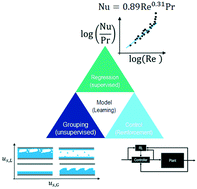
React. Chem. Eng., 2022,7, 1471-1509
https://doi.org/10.1039/D1RE00541C
Low-cost machine learning prediction of excited state properties of iridium-centered phosphors
Neural networks are used to predict iridium phosphor excited state properties at accuracy competitive with TDDFT, enabling high-throughput screening.

Chem. Sci., 2023,14, 1419-1433
https://doi.org/10.1039/D2SC06150C
Forecasting molecular dynamics energetics of polymers in solution from supervised machine learning
Recurrent neural networks as a machine learning tools are gaining popularity in chemical, physical and materials applications searching for viable methods in the structure and energetics analyses of systems ranging from crystals to soft matter.

Chem. Sci., 2022,13, 7021-7033
https://doi.org/10.1039/D2SC01216B
Using a supervised machine learning approach to predict water quality at the Gaza wastewater treatment plant
This paper presents the use of a machine learning approach to predict the performance of a Gaza wastewater treatment plant.

Environ. Sci.: Adv., 2024,3, 132-144
https://doi.org/10.1039/D3VA00170A
Accelerating materials discovery using integrated deep machine learning approaches
Our work introduces an innovative deep machine learning framework to significantly accelerate novel materials discovery, as demonstrated by its application to the La–Si–P system where new ternary and quaternary compounds were successfully identified.

J. Mater. Chem. A, 2023,11, 25973-25982
https://doi.org/10.1039/D3TA03771A
Accurate prediction of carbon dioxide capture by deep eutectic solvents using quantum chemistry and a neural network
We report the development of machine learning model for the calculation of carbon dioxide solubilities in deep solvent solvents. This model helps to predict and accelerate the development of carbon capture solvents with ideal experimental conditions.

Green Chem., 2023,25, 3475-3492
https://doi.org/10.1039/D2GC04425K
Insights into the deviation from piecewise linearity in transition metal complexes from supervised machine learning models
Artificial neural networks trained on 23 density functional approximations (DFAs) from multiple rungs of “Jacob's ladder” enable the prediction of where each DFA has zero curvature for chemical discovery.
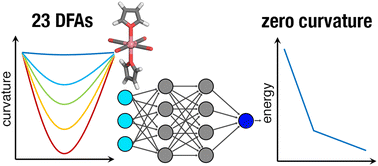
Phys. Chem. Chem. Phys., 2023,25, 8103-8116
https://doi.org/10.1039/D3CP00258F
Prediction of total organic carbon and E. coli in rivers within the Milwaukee River basin using machine learning methods
Ensemble-hybrid ML models can explain and predict the variability in water quality parameters and living microorganism behavior in natural streams with satisfactory prediction accuracies based on specific physicochemical parameters.

Environ. Sci.: Adv., 2023,2, 278-293
https://doi.org/10.1039/D2VA00285J
Data-driven approach for the prediction of mechanical properties of carbon fiber reinforced composites
Supervised machine learning models are trained on experimental data to predict the mechanical properties of composite materials. Results show that these techniques are reasonably accurate and generalizable.

Mater. Adv., 2022,3, 7319-7327
https://doi.org/10.1039/D2MA00698G
Sensitive rGO/MOF based electrochemical sensor for penta-chlorophenol detection: a novel artificial neural network (ANN) application
Reduced graphene oxide/metal organic framework based electrochemical sensor coupled with machine learning for sensitive detection of penta-chlorophenol.

Sens. Diagn., 2022,1, 1032-1043
https://doi.org/10.1039/D2SD00100D
A smartphone-interfaced, low-cost colorimetry biosensor for selective detection of bronchiectasis via an artificial neural network
Detection of bronchiectasis from exhaled breath.

RSC Adv., 2022,12, 23946-23955
https://doi.org/10.1039/D2RA03769F
Advanced artificial synaptic thin-film transistor based on doped potassium ions for neuromorphic computing via third-generation neural network
A novel technology of doping potassium ions to enhance the synaptic characteristics of synaptic thin-film transistors. The classifier of Spiking Neural Network with significant energy efficiency was successfully operated based on the proposed device.

J. Mater. Chem. C, 2022,10, 3196-3206
https://doi.org/10.1039/D1TC04827A
Machine learning enhanced spectroscopic analysis: towards autonomous chemical mixture characterization for rapid process optimization
A supervised machine learning algorithm is developed to determine the concentrations of chemical species in multicomponent solutions from their Fourier transform infrared (FTIR) spectra.
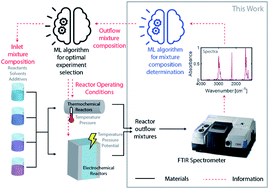
Digital Discovery, 2022,1, 35-44
https://doi.org/10.1039/D1DD00027F
About this collection
This cross-journal collection celebrates the 2024 Nobel Prize in Physics by bringing together research published on the use of machine learning and artificial neural networks to facilitate new and important discoveries. Through this important work, machines can now mimic functions such as memory and learning, enabling them to provide crucial assistance to humans for purposes such as uncovering new functional materials. This collection highlights work on the importance of artificial neural networks in materials science, nanoscience, physical chemistry, and more.